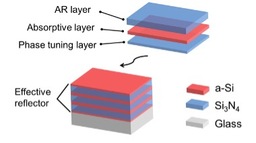Decorative Near-Infrared Transmission Devices
TECHNOLOGY NUMBER: 2019-121

OVERVIEW
Decorative, visibly-opaque but near-infrared-transmitting filters- Reflect a desired color without reducing NIR transmission efficiency
- Requires only a thin film, therefore amenable to scale up manufacturing
BACKGROUND
Infrared light has a wavelength that is just longer than that of visible light, and therefore cannot be seen by the naked eye. Still, infrared radiation has proven valuable for innumerable applications, including night vision apparatus, spectroscopy, photographic imaging, communications, and even decorative displays. Filters which block visible light and other forms of electromagnetic radiation but that allow the passage of near-infrared (NIR) light have great utility. Many NIR filters rely on organic dyes or pigments to absorb visible or ultraviolet light, though they suffer limitations due to photo and environmental instability. Additionally, other stable NIR filter options are costly and inefficient to manufacture. As such, a need exists for filters that are free from these limitations.
INNOVATION
Researchers have invented decorative, visibly-opaque but near-infrared-transmitting filters that possess high-efficiency and angular-insensitivity. These filters employ one-dimensional ternary photonic crystals to absorb visible light while allowing infrared light to pass through. The device permits generation of different reflective colors without affecting the near-infrared transmission performance. This structure utilizes stacking of seven layers of photonic crystals and semiconductor materials that also allow for the reflection of a desired color. This reflection of colored light enables the hiding of objects behind said filters without disrupting transmission efficiency. The other notable advantages of this filter are high angle invariant properties that produce mirror-like images over a wide-angle range, along with the requirement of only a thin film deposition layer for fabrication, which is highly amenable to scale-up manufacturing. This advancement opens up new possibilities for a variety of applications such as image sensors, optical detections, and NIR decorations.
PATENT APPLICATION
Number: 16/689,701